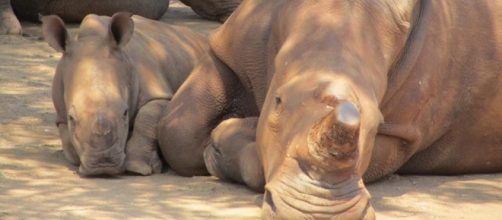In 1977, a CITES law banning trade in Rhino horn was passed. At the same time, the South African government took the unprecedented step towards long-term rhino conservation by allowing private landowners to keep rhinos.
Historical records show that this was a successful method of saving South Africa’s rhino. Over the next 30 years, two rhino subspecies in other countries became extinct and the rest of the world saw a decline in rhino populations of 90%. South Africa, through private ownership, was able to increase their rhino population to more than 15000 animals.
It was so successful that South Africa was able to export rhino.
The rhino conservation success in South Africa can be attributed to:
- South Africa allowed a national legal trade in rhino horn from private owners, where the animal was not killed to recover the horn.
- Extremely well-regulated trophy hunting concessions.
- Green hunting, whereby a hunter could shoot an animal with a dart so that they could be translocated or examined for veterinary and research purposes.
In 2008, South Africa restricted trophy hunts. Even the green hunts were stopped. Five years later in 2013, without any explanation all the South African national trade in rhino horn was banned.
The Result of the ban
The effect of the ban on national trade in rhino horn resulted over in 5000 rhinos being poached over the next two years.
These rhinos were killed through the illegal trade in rhino horn that exploded after the national ban.
The figures show very clearly that the dramatic increases in poaching in South Africa were a direct result of the law that now bans the legal national trade of rhino horn. Through legal national trade, the rhino’s would not have to die. Without legal trade, the entire trade in rhino horn is now illegally carried out and the criminal monopoly of the trade which has arisen will destroy the remaining rhino populations in the next seven to ten years.
The future of the rhino.
The anti-poaching war in South Africa has innumerable people from all over the world who are very supportive. Their donations pour into organisations who want to save the rhino, but at least one private rhino breeder who has funded their own rhino war over the past six years, states they have never been offered or received any donations from any fundraising organisation.
For John and Albina Hume, keeping their rhinos alive costs them millions of South African Rand monthly, most of which is funded from their timeshare properties. They ask a very valid question: How are rhino owners supposed to provide protection for their rhinos when they are not able to make any income from legally obtained horn which will grow back and can be easily re-harvested?
Albina, an author and pro-rhino activist with Future4Rhino worries, “What will happen when my husband and l run out of funds?”
The bottom line is that the black market rhino dealers are illegal and are killing rhino for their horns. Legal and licensed commercial owners should be allowed to legally harvest their horns as they are not killing their rhino to do so.
Legal rhino horn would drop the price of the productand make it less lucrative for the poaching cartels.
There are two very separate kinds of rhino horn trade. Firstly, there is the illegal one which is flourishing because of the ban on rhino trade and is driving the rhino to extinction. Secondly, there are private commercial owners who could very easily trade legally if the law was changed. This would involve no loss of life.
Without changes to the trade laws, the illegal cartels will eventually kill every rhino in South Africa despite all the great and admirable efforts of anti-poaching organisations. The time has come for the South African government to take urgent steps to change the status quo, which is so obviously not working. The CITES law only benefitsthe illegal cartels.
8 Fantastic world heritage sites in South Africa
South African beaches recognised at launch of the Blue Flag season

